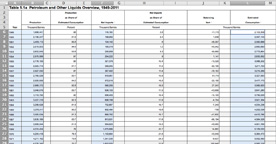 (click
for a larger view)
(click
for a larger view)
America’s appetite for energy as it industrialized was prodigious, roughly quadrupling between 1880 and 1918. Coal fed much of this growth, while electricity expanded in applications and total use alike. Petroleum got major boosts with the discovery of Texas’s vast Spindletop Oil Field in 1901 and with the advent of mass-produced automobiles, several million of which had been built by 1918.
In the years after World War II, “Old King Coal” relinquished its place as the premier fuel in the United States. The railroads lost business to trucks that ran on petroleum and also began switching to diesel locomotives themselves. Labor troubles and safety standards drove up coal production costs. The declining demand for natural gas as an illuminant forced that industry to look for other markets. Heating applications had obvious potential, and natural gas replaced coal in many household ranges and furnaces. The coal industry survived in part because nationwide electrification created new demand for coal among electric utilities despite regional competition from hydroelectric and petroleum-fired generation.
Most energy produced today in the United States, as in the rest of the industrialized world, comes from fossil fuels—coal, natural gas, crude oil, and natural gas plant liquids. Although U.S. energy production draws from many sources, fossil fuels together far exceed all other forms. In 1999 they accounted for 80 percent of total energy production and were valued at an estimated $94 billion. This exercise is designed to look first at coal and its occurrence, and then at petroleum production, consumption, and importation in the U.S. between 1949-2011. For additional background information read Energy perspectives: 1949- 2011 and also study this chart of US energy consumption since 1775. Then proceed with this exercise.
- A = YEAR
- B = PRODUCTION, which is the total amount of domestic petroleum produced in the U.S.
- F = NET IMPORTS, which is the amount of foreign oil imported minus the amount exported.
- L = ESTIMATED CONSUMPTION, which is the total amount of petroleum consumed in the U.S.
 (click
for a larger view)
(click
for a larger view)